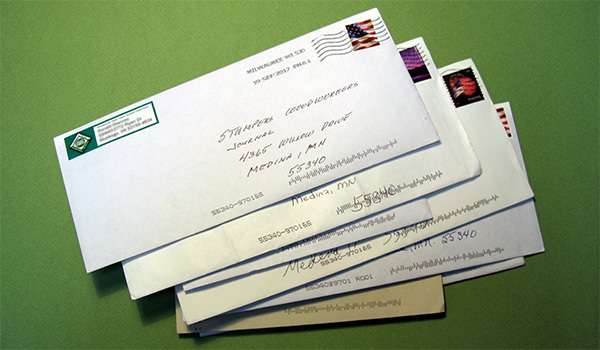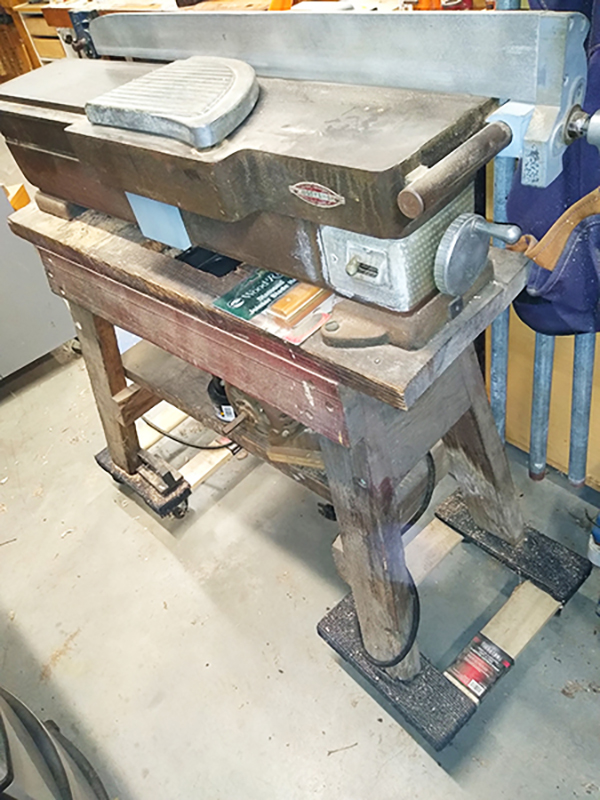
Last week Rob divulged that he’s now the owner of a vintage 6″ Craftsman jointer. Several of you congratulate his good fortune. – Editor
“I got a kick out of your article because I can relate! I have an old Atlas Press model 6001 jointer that works great. I’m nursing the knives, though, as a few of the set screws retaining the spacers and blades are seized. Just last week I sheared off the head of an Allen wrench trying to unscrew it. I have been curious about investing in a Shelix spiral cutterhead, but I am leery due to the price tag.” – Todd Allen
“I also was the beneficiary of a friend’s old Craftsman jointer. It’s a solid, heavy unit that seemed to cut pretty cleanly. Two caveats: 1) The porkchop blade guard is cast (aluminum?) and pretty brittle. Be sure it doesn’t hit the floor whenever you’re adjusting or replacing blades. Replacements are scarce and way overpriced when you can find one. 2) The fence is anchored at the end and subject to some deflection. Not a huge issue unless you’re trying to flatten a full six-inch board. Yours is newer than mine, so maybe they fixed that. One day my wife sent me a note that she had purchased my birthday present. Her only hint was that it was in the driveway and blue. We had been looking at new cars recently, but when I got home, no new car. She gave me her keys and suggested I check her back seat. There was a big blue box with Delta logo. She had been at Lowe’s and found they were selling out their stock of 37-190 jointers, which were their $399 floor-standing model. She got a deal, and I got a new jointer. It’s not a pro-quality unit, but it has served me pretty well for over 10 years. My son wants to buy an SCM convertible jointer-planer and may sell me his Powermatic HH unit, so I might be taking another step up soon. Enjoy the Craftsman. I love heavy old cast-iron tools.” – Draggman
“I have that same Craftsman jointer. I love it, but it does not have the blade cover. I also have a 1940 Craftsman drill press that I bought from my uncle’s estate. Craftsman built these tools to last.” – Mark Riffle
“I haven’t used my jointer for straightening much in the 50 years that I have been in business. I usually use my table saw for that. To do it, I first, put the curved edge against the fence and trim the other edge a hair. Then I turn it around and trim by the amount of gap on the curved side. If necessary, repeat steps one and two until all is straight. This is especially handy on heavy or long boards. I do like to use the jointer for tapering.” – Robert Galusha
“I’m still using my wife’s grandfather’s 1938 Craftsman lathe and a 1970s Delta-Rockwell table saw. Both just keep humming along. Thanks for sharing.” – John Chidester
“The picture of your ‘new’ jointer looks like the Craftsman jointer I inherited from my father. I have trouble keeping the belt pulley on the cutter head, other than that it works well for small boards. Great stuff. Thanks!” – Duane Mundt
“Your jointer looks in ‘like new’ condition. Here’s my well-used, same model Craftsman as yours (see below). It was given to me by a friend in his 70s. It was his dad’s. It came mounted to an old rough-cut lumber saw horse. It is stout and I needed a way to move it around. So for the time being, I have it sitting on two small furniture dollies, which works. This thing is heavy! Then I touched up the blades, mounted the motor and painted the fence parts. The depth adjustment will creep back to 1/32″ and then stay there. That is about the right depth of cut. But I need to fix that. I hope I can find parts, if needed. It works great and I enjoy it. You should get a lifetime or two of loyal service from yours.” – Charlie D.






